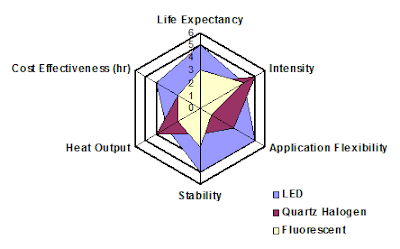Generally, machine vision has three technical advantages: Acquisition Technology, Processing Technology, and Motion Control Technology. Choosing different machine vision light source is in order to acquire high contrast and high quality images. It is very importanrt to choose a high quality and appropriate light source for creating a robust and timely vision inspection.
Types of illumination
The following lighting sources are now commonly used in machine vision:
1. Fluorescent light (high frequency)
2. Quartz Halogen incandescent lamps – Fiber Optics
3. LED - Light Emitting Diode
4. Metal halide light sources (as "cold light" sources with fibre optic transmission)
5. Xenon strobe lamps and metal halide lamps are used quite rarely in industrial machine vision
Fluorescent, quartz-halogen, and LED are by far the most widely used lighting types in machine vision, particularly for small to medium scale inspection stations, whereas metal halide and xenon are more typically used in large scale applications, or in areas requiring a very bright source. Metal halide, also known as mercury, is often used in microscopy because it has many discrete wavelength peaks, which complements the use of filters for fluorescence studies. A xenon source is useful for applications requiring a very bright, strobed light.
The figure-1 is a comparison and contrast of common vision lighting sources which shows the dvantages and disadvantages of fluorescent, quartz halogen, and LED lighting types.
Figure-1 Comparison and contrast of common vision lighting sources
Advantages of LED lighting
1. It’s capable to be design in almost any housing shapes for different machine vision purpose.
2. Its light colour is not only white, but also red, green or blue, infrared or even ultraviolet. And the light intensity could be adjusted by light control units.
3. It has a long life expectancy compared to other lighting.
Type
|
Fluorescent light
|
Halogen incandescent lamps
|
LED Lighting
|
Life expectancy
|
1500-3000hrs
|
1000hrs
|
30000hrs
|
4. Quick resopnse: it could achieve the maximum brightness in 10μs or even less.
5. It could be use as a strobe light by control units.
6. It also could be customized easily according to specific needs.
Therefore, LED lightings are widely used in many industrial machine vision applications.
ConstrasTech’s LED machine vision light source distinguishes itself by high intensity, high brightness and a long life time. And we are still devoted tocontinuously develop new products and improve its functionality. Now we already have a variety of LED machine vision lights available now.
 |
| Machine Vision Lights |
Contact
Hangzhou ContrasTech Co.,Ltd
Add.: No.11, Xiyuan 8th Road West Lake District,
Hangzhou 310030 China
TEL: 86-571-89712238
Fax: 400-8266-163*01460
Web site: www.contrastech.com
E-mail: market@contrastech.com/sales6@contrastech.com








